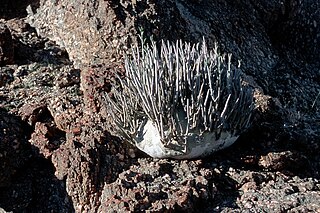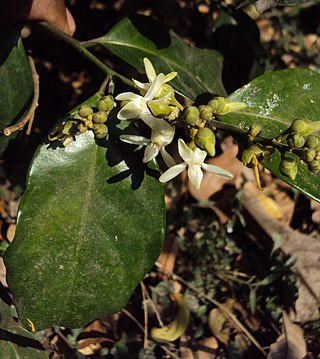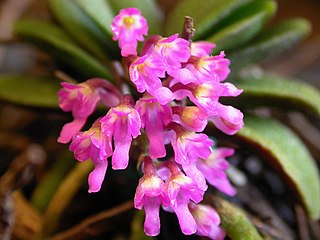
Virola is a genus of medium-sized trees native to the South American rainforest and closely related to other Myristicaceae, such as nutmeg. Species are known commonly as epená, patricá, or cumala. They have glossy, dark green leaves and clusters of tiny yellow flowers, and may emit a pungent odor.

Adenia is a genus of flowering plants in the passionflower family Passifloraceae. It is distributed in the Old World tropics and subtropics. The centers of diversity are in Madagascar, eastern and western tropical Africa, and Southeast Asia. The genus name Adenia comes from "aden", reported as the Arabic name for the plant by Peter Forsskål, the author of the genus.

Cissus is a genus of approximately 350 species of lianas in the grape family (Vitaceae). They have a cosmopolitan distribution, though the majority are to be found in the tropics.

Macaranga is a large genus of Old World tropical trees of the family Euphorbiaceae and the only genus in the subtribe Macaranginae. Native to Africa, Australasia, Asia and various islands of the Indian and Pacific Oceans, the genus comprises over 300 different species. It was first described as a genus in 1806, based on specimens collected on the Island of Mauritius.

The Myristicaceae are a family of flowering plants native to Africa, Asia, Pacific islands, and the Americas and has been recognized by most taxonomists. It is sometimes called the "nutmeg family", after its most famous member, Myristica fragrans, the source of the spices nutmeg and mace. The best known genera are Myristica in Asia and Virola in the Neotropics.

Hydnocarpus is a genus of medium to large trees in the Family Achariaceae; the genus was previously placed in the now defunct family Flacourtiaceae. Species have been recorded from Indochina, Indonesia, Malaysia and the Philippines.
Dischidia is a genus of plants in the “dog-bane” family Apocynaceae, collectively known as the “milkweeds”. They are epiphytes, native to tropical areas of China, India as well as Bhutan’s southern borders, wherever minimal frost occurs. Additionally, they are known from most areas of Indo-China, including forested areas of Myanmar, Thailand, Vietnam, Cambodia, Laos, and some parts of Malaysia and Singapore.

Horsfieldia is a genus of evergreen trees. The genus consists of about 100 species and is distributed across South Asia, from India to the Philippines and Papua New Guinea. Some species are used for timber. Species in the genus sometimes contain alkaloids, including horsfiline, which has analgesic effects.

Knema is a genus of plant in family Myristicaceae, mostly consisting of small-medium trees found in lowland tropical forests from south and northeast of India, Indochina, Malay Archipelago to near the tip of New Guinea. The highest diversity of species is in Borneo in west of Malesia.

Myristica globosa is a species of plant in the family Myristicaceae. It is found in parts of Melanesia and Australia.

Polyalthia is a genus of flowering plants in the family Annonaceae. There are approximately 90 species distributed from Africa to Asia and the Pacific.

Xanthophyllum is a genus of about 109 species of trees and shrubs, of the plant family Polygalaceae;. The generic name is from the Greek meaning "yellow leaf", referring to how the leaves are often yellow when dry. In Borneo it is known as minyak berok in Malay or nyalin in the Iban language.

Schoenorchis, commonly known as flea orchids, or 匙唇兰属 in Chinese, is a genus of flowering plants from the orchid family, Orchidaceae. Plants in this genus are small epiphytes with thin roots, thin leafy stems with leaves in two ranks and tiny fragrant, almost tube-shaped flowers with a prominently spurred labellum. There are about twenty five species found from tropical and subtropical Asia to the Western Pacific.

Myristica lepidota is a species of tree in the family Myristicaceae. It is found in E Moluccas and W & SW New Guinea. There are two subspecies contained within:













